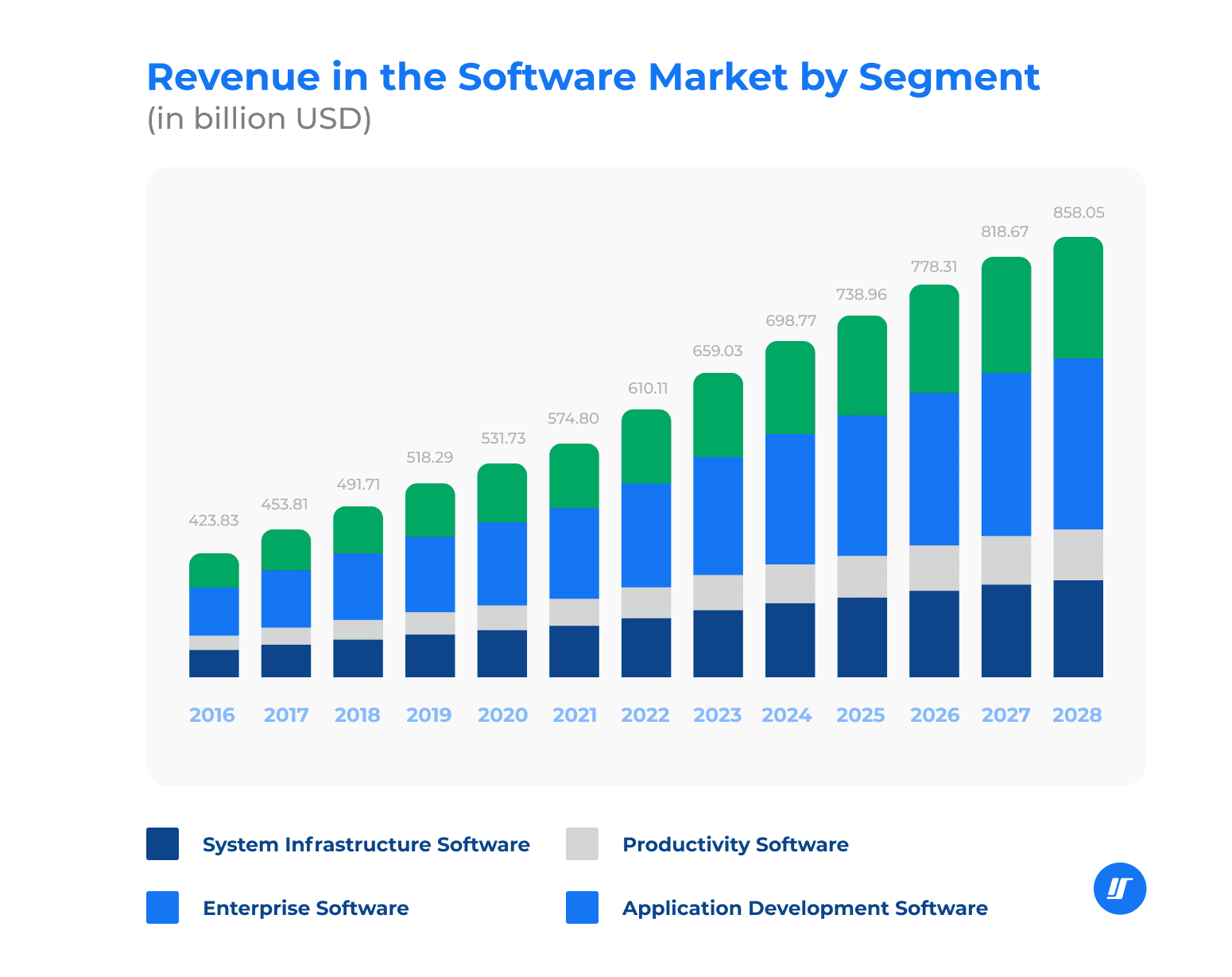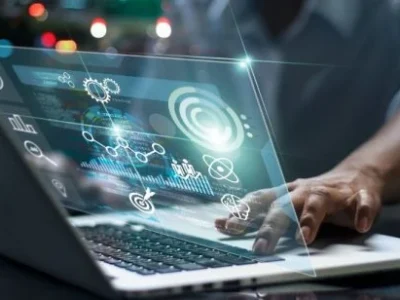At present, software development isn’t just a tool—it’s the engine driving innovation, transformation, and global connectivity. As businesses face increasing competition and rapidly evolving demands, software has become their greatest ally, unlocking infinite possibilities across industries.
From revolutionizing healthcare with AI-powered diagnostics and virtual care platforms to reshaping retail with personalized e-commerce and seamless supply chain management, software is redefining how industries operate.
Finance relies on robust systems for secure transactions and predictive analytics while manufacturing benefits from automation and IoT-powered smart factories. Moreover, education, entertainment, and logistics are also witnessing profound shifts, with applications that enhance accessibility, engagement, and efficiency.
Whether it’s a sleek mobile app, a cloud solution, or an integrated IoT platform, software development bridges the gap between traditional business processes and modern technologies. Not to mention ,small startups are disrupting markets with innovative apps, while large enterprises are embracing digital transformation to maintain a competitive edge.
The Evolving Trends Of 2024
As artificial intelligence, blockchain, and augmented reality continue to evolve, software development ensures businesses are not just keeping pace with change but actively driving it. Especially in a world increasingly defined by digital experiences, software development stands at the core of progress, enabling industries to thrive in the face of constant innovation.
And so, here are the top 5 trends in software development that are reshaping the industry by enabling smarter, faster, and more secure solutions.
-
-
Low-Code/No-Code Development
-
Low-code/no-code development is revolutionizing the software industry by empowering individuals with little or no coding experience to build powerful applications. This approach democratizes development, enabling faster delivery of solutions and fostering innovation without the need for extensive programming knowledge.
Businesses are leveraging these platforms to cut development costs, reduce time-to-market, and scale operations seamlessly. With intuitive drag-and-drop interfaces and pre-built components, low-code/no-code is transforming how software is created, making it accessible to developers and non-developers alike. Here’s a closer look at its impact:
Where It’s Used: Industries such as healthcare, education, retail, and finance are adopting low-code/no-code for a range of applications, including patient management systems, online learning portals, e-commerce platforms, and automated financial processes.
Platforms in Action: Notable tools like Shopify for e-commerce, Airtable for collaborative databases, and Bubble for web applications showcase the power and versatility of this approach in creating robust, scalable solutions.
By the Numbers: Gartner predicts that by 2025, 70% of new applications will be built using low-code/no-code platforms. Additionally, organizations adopting these tools report up to a 50% reduction in development costs and significantly faster project completion times.
This trend is reshaping the development landscape, enabling faster innovation and broader participation in software creation.
-
-
Augmented Reality
-
Augmented Reality (AR) is transforming the way we interact with technology by blending digital elements into our physical world. With its ability to enhance real-world environments through immersive experiences, AR is driving innovation across industries and changing how businesses engage with customers.
From retail to education, AR applications are creating new opportunities for growth and creativity. By overlaying virtual content onto real-world settings, AR delivers unique, interactive solutions that captivate users and provide value. Here’s how AR is making an impact:
Industries Adopting AR: Retailers use AR for virtual try-ons, real estate firms offer immersive property tours, healthcare providers enhance medical training, and the entertainment industry delivers engaging experiences through AR-based games and apps.
AR in Action: Famous platforms like IKEA Place allow users to visualize furniture in their homes, Pokémon GO captivated millions with its location-based AR gameplay, and Snapchat integrates AR filters to enhance social media interactions.
By the Numbers: The global AR market is projected to reach $97.76 billion by 2028, with 70% of consumers expecting AR to play a significant role in their shopping experiences. Companies leveraging AR report increased customer engagement and higher conversion rates.
Augmented Reality is not just a technology; it’s a tool reshaping how we see and interact with the world around us.
-
Blockchain Beyond Cryptocurrencies
Blockchain technology is making waves far beyond its original use in cryptocurrencies, unlocking new possibilities across various industries with its decentralized, transparent, and secure nature. By enabling tamper-proof record-keeping and real-time verification, blockchain is transforming traditional processes, enhancing trust, and fostering innovation.
Its versatility allows businesses to optimize operations, reduce fraud, and streamline data sharing, making it a cornerstone for future advancements. Here’s how blockchain is shaping the world beyond digital currencies:
Industries Leveraging Blockchain: Healthcare uses it for secure patient data management, supply chains ensure product authenticity and traceability, the real estate sector simplifies property transactions, and governments are adopting blockchain for transparent voting systems.
Blockchain Applications: Platforms like IBM Food Trust ensure traceable food supply chains, VeChain offers end-to-end blockchain solutions for logistics, and OpenSea is revolutionizing the digital art world with NFTs.
By the Numbers: By 2030, blockchain technology is expected to generate over $3.1 trillion in business value, with 81% of top companies exploring blockchain use cases. Its adoption in supply chains alone can save global businesses $31 billion annually by reducing inefficiencies.
Blockchain is no longer confined to cryptocurrency—it’s a powerful tool driving trust, efficiency, and innovation across countless sectors.
-
Artificial Intelligence and Machine Learning
Artificial Intelligence (AI) and Machine Learning (ML) are at the forefront of technological transformation, enabling machines to think, learn, and make decisions like never before. From powering predictive analytics to automating complex tasks, these technologies are revolutionizing industries by enhancing efficiency, accuracy, and scalability.
By leveraging vast datasets, AI and ML are helping businesses uncover insights, personalize user experiences, and innovate at an unprecedented pace. Here’s how they’re making an impact:
Industries Using AI and ML: Artificial Intelligence and Machine Learning are transforming healthcare through AI-driven diagnostics, enhancing retail with personalized shopping experiences, optimizing logistics with smart supply chain solutions, and advancing finance with fraud detection and algorithmic trading.
AI and ML Platforms: Tools like ChatGPT enhance customer interactions, Tesla’s self-driving technology showcases ML’s potential in transportation, and Netflix’s recommendation engine personalizes content for millions of users worldwide.
By the Numbers: The AI market is projected to grow to $1.8 trillion by 2030, with 90% of top-performing companies investing in AI. Businesses using ML report a 40% improvement in operational efficiency and up to a 25% boost in revenue through personalized services.
Artificial intelligence and Machine Learning are more than buzzwords; they are redefining innovation, pushing boundaries, and paving the way for a smarter, more connected future.
-
Internet Of Things
The Internet of Things (IoT) is revolutionizing how we connect and interact with the world around us, creating a truly interconnected ecosystem. By embedding sensors and connectivity into everyday objects, IoT allows devices to communicate with each other, collect data, and make intelligent decisions.
From smart homes to industrial automation, IoT is transforming industries by driving efficiency, enhancing productivity, and enabling new experiences. Here’s how IoT is making waves across the globe:
Industries Using IoT: In healthcare, IoT devices monitor patient vitals and enable remote care; in agriculture, smart sensors optimize crop yields; in manufacturing, IoT powers predictive maintenance; and in logistics, IoT ensures real-time tracking of goods.
IoT Platforms: Platforms like Amazon Alexa and Google Home bring smart home automation to the masses, Fitbit tracks fitness data, and smart thermostats like Nest learn user preferences to optimize energy use.
By the Numbers: The global IoT market is expected to reach $1.6 trillion by 2025, with over 75 billion connected devices worldwide. IoT adoption can reduce business operating costs by up to 20% and improve asset utilization by 30%.
IoT is not just about connecting devices—it’s about creating smarter, more efficient systems that redefine how we live, work, and interact with the world.
The Digital Revolution Ahead
Precisely, emerging technologies like low-code/no-code development, augmented reality, blockchain, AI, machine learning, and IoT are reshaping industries and driving innovation at an unprecedented rate. These advancements are not just enhancing how businesses operate, but also creating new opportunities for growth, efficiency, and customer engagement.
As organizations continue to embrace these technologies, the future promises even greater potential for transformation across every sector. Staying ahead in this digital era requires adopting these technologies to remain competitive, agile, and connected.





